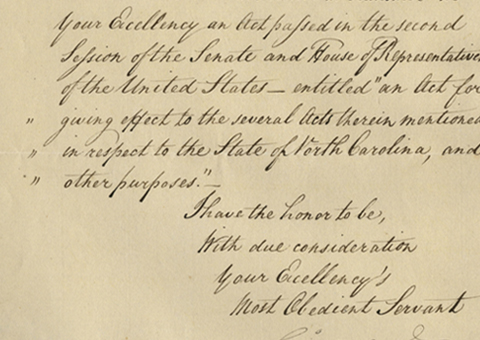Among the Rarest Autographs of the American Revolution: A Document Signed by Johannes de Graaff in December 1776, Just Weeks After He Gave the American flag, and American Independence, Its First International Salute

It sells a ship that was likely later to have served the American cause, and been taken prize by the British.
St. Eustatius is an island in the Caribbean that became a Dutch possession in the 17th century. In the 18th century its placement in the middle of the British, French, Spanish and Danish island territories, and its status as a free port with no customs duties, made it a major point for...
St. Eustatius is an island in the Caribbean that became a Dutch possession in the 17th century. In the 18th century its placement in the middle of the British, French, Spanish and Danish island territories, and its status as a free port with no customs duties, made it a major point for transhipment of goods, especially tobacco and sugar, and a locus for trade in contraband. Edmund Burke said of it in 1781, “Its proprietors had, in the spirit of commerce, made it an emporium for all the world… Its wealth was prodigious, arising from its industry and the nature of its commerce.”
The island sold arms and ammunition to anyone willing to pay and was one of the few places from which the rebellious Americans could obtain military stores. In fact, nearly half of all American Revolutionary military supplies were obtained through St. Eustatius, and nearly all American communications to Europe first passed through the island. The noted British diplomat Lord Storming told Parliament that “if Sint Eustatius had sunk into the sea three years before, the United Kingdom would already have dealt with George Washington.”
Johannes de Graaff was the Dutch governor of the island from September 1776 to November 1781, and he sympathized with the American cause. On November 16, 1776, just a few months after de Graaff took his position, Captain Isaiah Robinson of the 14-gun American brig Andrew Doria, which was flying the colors of the fledgling United States and there to purchase munitions for the American Revolutionary forces, sailed into the anchorage below St. Eustatius’ Fort Oranje [Fort Orange]. Robinson announced his arrival by firing a thirteen gun salute, one gun for each of the thirteen American states in rebellion against Britain. De Graaff, on his own initiative and without consulting his government, replied with an eleven gun salute from the cannons of Fort Oranje (international protocol required a two gun less acknowledgement of a sovereign flag). This was the famed “First Salute”, which was the first international acknowledgment of American independence. The Andrew Doria was carrying a copy of the Declaration of Independence, which was presented to Governor De Graaff.
Document signed, Sint Eustatius, December 7, 1776, just three weeks after recognizing American independence. In it, William Dent and Zuyt de Schelden sell the Ship Nancy to Messrs Thomas and Ashburner. Men of the Thomas and Ashburner names appear on a 1781 list of the burghers (residents) of Sint Eustatius.
The British were furious at the recognition and and protested to the Dutch government, which recalled de Graaff to the Netherlands. He explained his deeds at the Hague and was sent back to Sint Eustatius. In 1780 the British finally got fed up and declared war on the Dutch.
As for the Ship Nancy purchased here, it is quite possibly the vessel of that name that in 1779 was seized by the British on a journey from Baltimore to Sint Eustatius. They took it to occupied New York as a prize.
Consulting our own records and recollections, and public sale records going back four decades, we are unable to find any other example of de Graaff’s autograph having come up for sale. It may be the rarest autograph of the American Revolution.

Frame, Display, Preserve
Each frame is custom constructed, using only proper museum archival materials. This includes:The finest frames, tailored to match the document you have chosen. These can period style, antiqued, gilded, wood, etc. Fabric mats, including silk and satin, as well as museum mat board with hand painted bevels. Attachment of the document to the matting to ensure its protection. This "hinging" is done according to archival standards. Protective "glass," or Tru Vue Optium Acrylic glazing, which is shatter resistant, 99% UV protective, and anti-reflective. You benefit from our decades of experience in designing and creating beautiful, compelling, and protective framed historical documents.
Learn more about our Framing Services








































































































